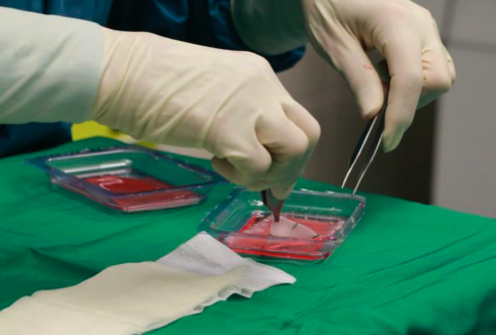By Katrin Flatscher
Butterfly disease has been called “the worst disease you’ve never heard of”. It’s an excruciatingly painful genetic condition that makes life miserable for the affected, and currently, there’s no cure. To make matters even worse, with as many as 27 different varieties of Epidermolysis bullosa (EB) and multiple genes/mutations, each patient is different, so there is no overarching, one-size-fits-all treatment solution. Despite its devastating effects on patients, mainly children and their families, funding is limited, as the disease is so rare: it affects only 1 in 20,000–50,000 of the population.
Yet, in attempting to understand and treat patients with this disease, scientists are learning a lot. This blog will explain what Epidermolysis bullosa is, and why it is called butterfly disease, and how research into this disease is providing valuable insights that benefit society as a whole.

What is Epidermolysis bullosa?
Epidermolysis bullosa (EB) is a genetic condition affecting the skin, connective tissues and mucosal membranes. The human skin is made up of three layers: the outer epidermis, middle dermis and inner hypodermis. There are connecting “anchors” between the epidermis and dermis, which are vital for maintaining the integral structure of these layers and preventing their independent movement.
“When I first heard about EB, it was quite hard to grasp the intensity of the condition. It’s about the most insane skin disorder you can imagine. And when you realize it also affects the internal organs, then you see it as diabolical.”¹
Eddie Vedder—American musician, member of rock band Pearl Jam and EBRP cofounder (EB Research Partnership, a non-profit dedicated to eradicating Epidermolysis bullosa)
Patients suffering from EB lack these supporting anchors as a result of a genetic mutation, leading to increased levels of friction between the layers of the skin and causing painful blisters and sores from the simplest physical movements. Minor injuries or scratching lead to open wounds that never heal completely, making the skin delicate like “butterfly wings”. Hence the young patients suffering from EB are often referred to as “butterfly children”.
Why haven’t I heard of the butterfly disease before?
With the prevalence of the disease as low as eleven live births per million in the USA² and ten live births per million in Australia³, studies in the UK recorded a prevalence of 15-32 cases per million live births⁴. Low prevalence of diseases equals low commercially available medication. In this case, unfortunately, no cure exists. International organizations such as DEBRA (The Dystrophic Epidermolysis Bullosa Research Association), “I Refuse EB”, and a few more organizations are striving to create awareness of this rare disease and obtain research funding.
What types of EB exist?
Based on prevalence and severity, EB is broadly categorized into three types:
- EB Simplex: Usually a dominant trait, EB simplex (EBS) is inherited when both parents carry a recessive copy. Approximately 70% of EB patients exhibit EBS and develop blisters – mostly on hands and feet, sometimes all over their body. The blisters are itchy and highly prone to infections.
- Dystrophic EB: Observed in 20% of total EB cases, dystrophic EB (DEB) can either be inherited as a dominant or a recessive trait. The severity of the symptoms varies from person to person and intensifies with age. Dominant EB is less severe, allowing some patients to lead an almost normal life. Recessive DEB is more life-threatening, leading to the development of an aggressive form of skin cancer—squamous cell carcinoma – before the age of 35.
- Junctional EB: Prevalent in 10% of EB patients, junctional EB (JEB) is recessively inherited from both carrier parents. JEB is further categorized into JEB generalized severe and JEB generalized intermediate. JEB generalized severe is fatal in infants with very few patients surviving until the age of 2 or 3. The survivors ultimately succumb to the disease due to anemia and malnutrition, as the esophagus and trachea are also affected. JEB generalized intermediate is a milder form of the disease that inflicts lifelong pain and usually disability.)
.jpg?width=694&name=sub-header_Schuhe_eng_10%20(1).jpg)
(Photo: GGK MullenLowe)
Three examples of EB research providing insights that benefit society
1. Skin cancer
The damaged and weak skin of EB patients makes them more prone to aggressive skin cancers, for which standard treatments like radiotherapy and chemotherapy are not very successful. This is sparking new research into more effective and targeted cancer treatment strategies such as the introduction of suicide genes into cancer cells.
People with EB are at higher risk than healthy individuals of developing squamous skin cancer (SSC) and basal cell carcinoma (BCC). EB simplex patients are more susceptible to BCC, while recessive dystrophic epidermolysis bullosa (RDEB) patients have an extremely high chance of developing a very aggressive version of SCC with a low prognosis of successful treatment.
Understanding the mechanisms behind the aggressive progression of SSC in EB patients is not only advantageous in curing this type of cancer in RDEB patients but also in discovering novel treatments for SSC in the rest of the population. Understanding the specificity of EB patients developing severe cancers could offer a new perspective on a general understanding of cancer as well as drug development strategies for EB and skin cancers.
Extensive research into cancer in EB is attempting to answer these questions⁵:
- What genetic and cellular characteristics make EB skin more prone to development and metastasis of SSC?
- Which of the findings in EB SCC may provide targets for anti-SCC drug development?
- How can we make better use of SCC tissue biopsies as a research resource?
- Why do chronic wounds and inflammation trigger SCC initiation and how can we identify druggable targets?
2. Gene therapy
Recently, a research team in Italy successfully grafted 80% of the outer epidermis on a 7-year-old butterfly child, using stem cells and gene therapy. The gene LAMB3 — responsible, among others, for the production of the protein laminin-332 — plays a crucial role in this procedure, as genetic mutations causing EB affect the production of this protein.
Skin cells from unblistered regions of the patient’s body were harvested and genetically modified to express the unmutated gene, thus producing normal concentrations of the laminin-322 protein. The corrected cells were then grown as grafts or patches under supervised laboratory conditions and transplanted back on to the patient. Cells from the individual patients used to create the grafts dramatically reduce if not eliminate the risk of graft rejection by the body. Skin grafts have been attempted in small patches over the years, but this is the first time that roughly 80% of skin was successfully grafted.⁶
3. Wound healing and scarring
Recent landmark progress in skin graft gives hope to butterfly children and their parents to lead a more normal life. Furthermore, this rare disease research has also increased our understanding of how skin forms, and how to genetically engineer it, with implications for the treatment of further diseases and damage affecting large areas of skin, e.g. in the treatment of burn victims.
The study of impaired wound healing in EB patients is helping researchers unravel the underlying mechanisms and genes involved in normal wound repair and scarring processes. These insights could lead to new gene therapies and treatments that facilitate wound healing and inhibit scarring, whatever the cause.
Summary
With everything we’re learning about butterfly disease, it seems to present a strong case for better funding of research for this and other rare diseases. Nevertheless, the challenges of working on a limited budget are unlikely to disappear anytime soon.
Tecan offers innovative and flexible automation solutions that are helping rare disease researchers make the most of precious resources to progress their vital research more cost efficiently. To learn more, download our application guide.
References
1. EB Info World, 2017.
2. Medline Abstract for Reference 8 of 'Epidemiology, pathogenesis, classification, and clinical features of epidermolysis bullosa'. UpToDate Inc., 2018.
3. Medline Abstract for Reference 10 of 'Epidemiology, pathogenesis, classification, and clinical features of epidermolysis bullosa'. UpToDate Inc., 2018.
4. Medline Abstracts for References 11-13 of 'Epidemiology, pathogenesis, classification, and clinical features of epidermolysis bullosa'. UpToDate Inc., 2018.
5. Skin cancer in EB – Why is cancer research important? DEBRA international, 2018.
6. EB researchers break new ground with skin graft trial. DEBRA international, 2017.
About the author

Katrin Flatscher
Dr. Katrin Flatscher is an application scientist at Tecan Austria. She studied molecular biology at the University of Salzburg and focused on cell biology and immunology research during her PhD. She joined Tecan in 2007 and has been involved in the development of the Infinite as well as the Spark multimode reader series.











